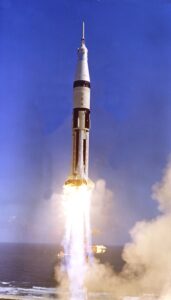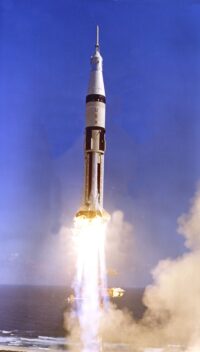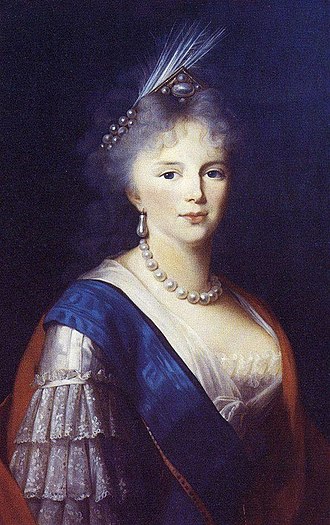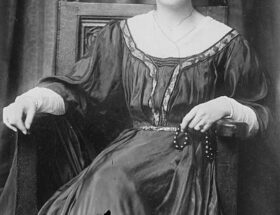
Insights on the Crew Members
The Apollo 7 crew was commanded by Walter M. Schirra with senior pilot/ navigator Donn F. Eisele and pilot/systems engineer R. Walter Cunningham.
Official crew titles were made consistent with those that would be used for the crewed lunar landing missions: Eisele was Command Module Pilot and Cunningham was Lunar Module Pilot.
Schirra, one of the original “Mercury Seven” astronauts, was born March 12, 1923 in Hackensack, New Jersey and graduated from the United States Naval Academy in 1945. He flew Mercury-Atlas 8 in 1962 (the fifth crewed flight of Project Mercury & the third to reach orbit) and was the command pilot for Gemini 6A. He was a captain in the Navy at the time of Apollo 7.
Eisele was born June 23, 1930 in Columbus, Ohio and graduated from the Naval Academy in 1952 with a B.S. in aeronautics. He elected to be commissioned in the Air Force and was a major at the time of Apollo 7.
Cunningham, a civilian, was born March 16, 1932 in Creston, Iowa. He received degrees in physics from UCLA, a B.A. in 1960 and an M.A. in 1961.
Both Cunningham and Eisele were selected as part of the third group of astronauts in 1963.
Mission Background
Schirra, Eisele and Cunningham were first named as Apollo crew on September 29, 1966. They were to fly a second Earth orbital test of the original Block I command and service module after Apollo 1.
In December 1966 the second mission was deemed redundant and canceled, and Schirra’s crew were reassigned as backup.
Plans for the first crewed Apollo flights were disrupted by the January 1967 cabin fire which killed Grissom, White, and Chaffee (Apollo 1’s crew).
Schirra, Eisele and Cunningham were later named as prime crew for the first crewed flight, which would now use the Block II spacecraft designed for the lunar missions.
The command module (CM) and astronauts’ spacesuits had been extensively redesigned, to reduce and eliminate the chance of a repeat of the accident which killed the first crew.
Schirra thus became the only astronaut to fly Mercury, Gemini and Apollo missions. His crew would test the life support, propulsion, guidance and control systems during this “open-ended” mission (meaning it would be extended as it passed each test).
The duration was limited to 11 days, reduced from the original 14-day limit for Apollo 1. Since it flew in low Earth orbit and did not include the lunar module (LM), Apollo 7 was launched with the Saturn IB booster rather than the much larger and more powerful Saturn V.
Throughout the Mercury and Gemini programs McDonnell Aircraft engineer Guenter Wendt had been leader of the spacecraft launch pad teams, with ultimate responsibility for condition of the spacecraft at launch. He earned the astronauts’ respect and admiration, including Schirra’s.
However, the spacecraft contractor had changed from McDonnell (Mercury and Gemini) to North American Rockwell (Apollo), so Wendt was not the pad leader for Apollo 1.
So adamant was Schirra in his desire to have Wendt back as Pad Leader for his Apollo flight, that he got his boss Deke Slayton to persuade North American management to hire Wendt away from McDonnell, and Schirra personally lobbied North American’s launch operations manager to change Wendt’s shift from midnight to day so he could be pad leader for Apollo 7. Wendt remained as Pad Leader for the entire Apollo program.
The Mission
On-orbit Operations
The first crewed American space flight in 22 months lifted from LC-34 at 15:02:45 UTC on Friday, October 11, 1968. Liftoff proceeded flawlessly as the Saturn IB performed well on its first crewed launch and there were no significant anomalies during the boost phase.
The astronauts described it as very smooth riding compared to the rough, bumpy Titan II used to launch the Gemini spacecraft.
During the countdown, the wind was blowing in from the east. To launch under these weather conditions was in violation of safety rules since in the event of a launch vehicle malfunction and abort, the command module would touch down on land in Florida, which would be rough and have the potential for the crew to be seriously injured or killed.
Apollo 7 was still equipped with the old Apollo 1-style crew couches, which did not provide adequate shock protection in the event of a terrestrial landing. The crew couches had been since redesigned, but the new units were not ready in time for the launch. While seated inside the command module, Schirra protested that launching with the wind going east to west was dangerous, but these complaints were ignored by the blockhouse crew.
Following orbital injection and separation from the S-IVB, the crew turned the CSM around using its Reaction Control System thrusters, and Eisele practiced a simulated lunar module rendezvous and docking, using a visual reference target mounted inside the spacecraft adapter in the same radial position it occupied on the LM.
One of the adapter panels on the S-IVB failed to completely deploy to its 45 degree open position. Had this been an actual lunar mission, the astronauts might have found the process of LM extraction from the adapter more difficult, risking possible damage. This reinforced the decision to add a system to completely separate and jettison the panels on all subsequent Apollo-Saturn V flights.
The Apollo hardware and all mission operations worked without any significant problems and the service propulsion system (SPS), the all-important engine that would place Apollo into and out of lunar orbit, made eight firings, performing within 1% of the engine acceptance test thrust and specific impulse values.
As the Saturn IB itself had performed very smoothly during launch, the astronauts were unprepared for the sudden violent jolt they received upon first activating the SPS, leading to Schirra yelling “Yabbadabbadoo!” in reference to The Flintstones cartoon. Don Eisele called it “a real boot in the rear”.
An assortment of minor hardware problems occurred over the flight: these included the drinking water hose trigger sticking during the final two days, a momentary undervoltage of the main AC buses caused by the automatic cryo fan switch in the service module LOX and LH2 tanks, and a loss of telemetry due to a malfunctioning electrical commutator following SM jettison at the end of the mission, meaning that the final 15 minutes of data transmission were lost.
Aside from the last event, which remained a mystery despite postflight testing of the commutator, all of the problems on Apollo 7 were quickly resolved and some of them also involved equipment or procedures that would not be used on subsequent missions.
Apollo promised the best space food. For the first time astronauts had both hot and cold water to prepare meals with (the food came in freeze-dried vacuum packs that would be injected with water or else eaten dry followed by a sip of water) and Schirra, who had had only toothpaste-like tubes for food on his Mercury flight, described the food as “still does not match home cooking, but it comes a lot closer than space food used to”.
Thirty-three meals were provided for the three crewmen, allowing them three meals a day for each of the 11 days in space. Even so, the astronauts complained that there was more food than they could eat and that most of it was too sweet, although the menus had been prepared based on their personal preferences.
Early fears that the movement of the astronauts inside the CM would make it hard for the spacecraft’s attitude control system to stabilize it proved unfounded, and they reported that motion was “incredibly easy” with no gravity to work against. As sleeping in the fetal position was cramping and painful, a stretching device called the Exer-Genie was provided for relaxing aching muscles.
Another mission goal was the first live television broadcast from an American spacecraft (Gordon Cooper had transmitted slow scan television pictures from Faith 7 in 1963, which were never broadcast).
It was initially scheduled for midday on day two, but Schirra was concerned with the broadcast interfering with the rendezvous test.
Space Mutiny
Even though Apollo’s larger cabin was more comfortable than Gemini’s, 11 days in orbit took its toll on the astronauts. Tension with Schirra began with the launch decision, when flight managers decided to launch with a less-than-ideal abort option for the early part of the ascent.
Once in orbit the spacious cabin may have induced some crew motion sickness, which had not been an issue in the earlier, smaller spacecraft. The crew were unhappy with their food selections, especially the high energy sweets. They also found the waste collection system cumbersome (requiring 30 minutes to use) and smelly.
But the worst problem occurred when Schirra developed a severe head cold. As a result, he became irritable with requests from Mission Control and all three astronauts began “talking back” to the CAPCOM.
An early example was this exchange after Mission Control requested that a TV camera be turned on in the spacecraft:
SCHIRRA: You’ve added two burns to this flight schedule, and you’ve added a urine water dump; and we have a new vehicle up here, and I can tell you at this point TV will be delayed without any further discussion until after the rendezvous.
CAPCOM (Jack Swigert): Roger. Copy.
SCHIRRA: Roger.
CAPCOM 1 (Deke Slayton): Apollo 7, this is CAPCOM number 1.
SCHIRRA: Roger.
CAPCOM 1: All we’ve agreed to do on this is flip it.
SCHIRRA: … with two commanders, Apollo 7
CAPCOM 1: All we have agreed to on this particular pass is to flip the switch on. No other activity is associated with TV; I think we are still obligated to do that.
SCHIRRA: We do not have the equipment out; we have not had an opportunity to follow setting; we have not eaten at this point. At this point, I have a cold. I refuse to foul up our time lines this way.
A further source of tension between Mission Control and the crew was that Schirra repeatedly expressed the view that the reentry should be conducted with their helmets off, contrary to previous Project Mercury and Gemini experience.
They perceived a risk that their eardrums might burst due to the sinus pressure from their colds and they wanted to be able to pinch their noses and blow to equalize the pressure as it increased during reentry.
This would have been impossible wearing the helmets, as the new Apollo helmets were a continuous “fishbowl” type without a moveable visor, unlike previous helmets.
However, on repeated occasions over the course of the mission, Schirra was instructed that the helmets should be worn for safety reasons. In the final exchange on the subject, Mission Control made it clear to Schirra that he would be expected to account for flouting instructions:
CAPCOM 1 (Deke Slayton): Okay. I think you ought to clearly understand that there is absolutely no experience at all with landing without the helmet on.
SCHIRRA: And there is no experience with the helmet either on that one.
CAPCOM 1: That one we’ve got a lot of experience with, yes.
SCHIRRA: If we had an open visor, I might go along with that.
CAPCOM 1: Okay. I guess you better be prepared to discuss in some detail when we land why we haven’t got them on. I think you’re too late now to do much about it.
SCHIRRA: That’s affirmative. I don’t think anybody down there has worn the helmets as much as we have.
CAPCOM 1: Yes.
SCHIRRA: We tried them on this morning.
CAPCOM 1: Understand that. The only thing we’re concerned about is the landing. We couldn’t care less about the reentry. But it’s your neck, and I hope you don’t break it.
SCHIRRA: Thank you, babe.
CAPCOM 1: Over and out.
Exchanges such as this led to Eisele and Cunningham being rejected for future missions (Schirra had already announced his impending retirement from NASA).
Crew Honors
After the mission NASA awarded Schirra, Eisele, and Cunningham its Exceptional Service Medal in recognition of their success. On November 2, 1968, President Lyndon Johnson held a ceremony at the LBJ Ranch in Johnson City, Texas, to present the astronauts with the medals.
He also presented NASA’s highest honor, the Distinguished Service Medal, to recently retired NASA administrator James E. Webb, for his “outstanding leadership of America’s space program” since the beginning of Apollo.
Schirra, Eisele and Cunningham were the only crew, of all the Apollo, Skylab, and Apollo-Soyuz Test Project missions, who had not been awarded the Distinguished Service Medal immediately following their missions (though Schirra had received the medal twice before, for his Mercury and Gemini missions).
Therefore, NASA administrator Michael D. Griffin decided to belatedly award the medals to the crew in October 2008, “for exemplary performance in meeting all the Apollo 7 mission objectives and more on the first crewed Apollo mission, paving the way for the first flight to the Moon on Apollo 8 and the first crewed lunar landing on Apollo 11.”
Only Cunningham was still alive at the time while Eisele’s widow accepted his medal and Apollo 8 crew member Bill Anders accepted Schirra’s.
Other Apollo astronauts, including Neil Armstrong, Buzz Aldrin and Alan Bean, were present at the award ceremony.
Former Flight Director Christopher C. Kraft Jr., who had been in conflict with the crew during the mission, sent a conciliatory video message of congratulations, saying: “We gave you a hard time once but you certainly survived that and have done extremely well since…I am frankly, very proud to call you a friend.”
Spacecraft Location
In January 1969, the Apollo 7 command module was displayed on a NASA float in the inauguration parade of President Richard M. Nixon. For nearly 30 years the command module was on loan (renewable every two years) to the National Museum of Science and Technology, in Ottawa, Ontario, along with the space suit worn by Wally Schirra.
In November 2003, the Smithsonian Institution in Washington, D.C., requested them back for display at their new annex at the Steven F. Udvar-Hazy Center.
Currently, the Apollo 7 CM is on loan to the Frontiers of Flight Museum located next to Love Field in Dallas, Texas.



